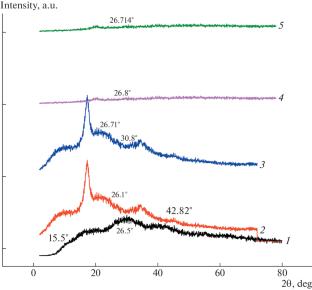Study of Structural, Thermal and Electrical Properties of Functionalized Multiwalled Carbon Nanotubes–Polyaniline Composites
Abstract—
This paper discusses the various ways for synthesizing polyaniline (PANI) and hybrid carbon nanotube (CNT) reinforced PANI nanocomposites. A series of polyaniline/functionalized multi-walled carbon nanotubes (PANI/f-MWCNTs) nanocomposites with varying concentrations (0–20% wt/wt) of f‑MWCNTs in PANI were prepared using in situ polymerization of aniline in an aqueous dispersion of f‑MWCNTs using FeCl3·6H2O as an oxidant. Functionalization of MWCNTs was achieved by their acid treatment. The dispersion of functionalized carbon nanotubes, filler concentration, and their alignment in the interior of PANI matrix affect their morphology. The structure and morphology of the obtained pure PANI and PANI/f-MWCNTs nanocomposites were characterized by using X-rays diffraction (XRD) and scanning electron microscopy (SEM). These techniques indicate that f-MWCNTs act as the core in the formation of a coaxial nanostructure. Thermogravimetric analysis (TGA) was carried out to study the thermal stability of the nanocomposites and the pristine polymer, which showed that the thermal stability of the nanocomposites increased with the increasing content of f-MWCNTs in PANI. The effect of MWCNT on the transport properties of PANI in the form of the transport parameters such as charge localization length, most probable hopping distance, and charge hopping energy in the temperature range 300–423 K was also studied.


 求助内容:
求助内容: 应助结果提醒方式:
应助结果提醒方式:


